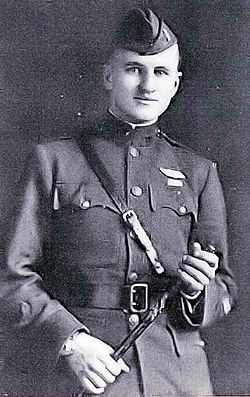John Owen Donaldson
| John Owen Donaldson | |
|---|---|

John Owen Donaldson, 1918
|
|
| Born | April 14, 1897 Fort Yates, North Dakota, USA |
| Died | September 7, 1930 (aged 33) Philadelphia, Pennsylvania, USA |
| Allegiance |
|
| Service/branch | Royal Air Force (United Kingdom) |
| Years of service | 1917–1918 |
| Rank | Captain |
| Unit |
Royal Air Force |
| Battles/wars |
|
| Awards | Distinguished Service Cross, British Distinguished Flying Cross, Belgian Croix de Guerre, Mackay Gold Medal |
Royal Air Force
Captain John Owen Donaldson (May 14, 1897 – September 7, 1930) was a World War I flying ace credited with seven aerial victories.
Donaldson was born in Fort Yates, North Dakota, the son of General Thomas Quinton Donaldson. He left Cornell and joined the Royal Flying Corps in Canada in March 1917. When the U.S. declared war, he transferred to the American air service. He was attached to the RAF (successor to the RFC), and posted to No. 32 Squadron RAF. From July 22 through August 29, 1918, he destroyed four Fokker D.VII fighters and drove down three others out of control.
On September 1, he was shot down by Theodor Quandt, and captured. The following day, he and another prisoner escaped and tried to steal a German two-seater for a flying exit. Donaldson received a bayonet wound in the back struggling with a sentry, and the refugee duo fled. On September 9, they were caught swimming a stream in no man's land, and re-incarcerated. Three days later, Donaldson, his companion, and three other POWs escaped; Donaldson made it to the Netherlands in October.
On 15 March 1920, Aerial Age Weekly reported that "Captain J. O. Donaldson, A.S.A., is now commanding the famous 94th Aero Squadron in place of the late Captain Field E. Kindley, A.S.A. Captain Donaldson is a military aviator with several decorations, and as squadron engineer officer for the 95th Squadron has shown himself an efficient and capable officer."
Donaldson won the U.S. transcontinental air race in October 1919, and was awarded the Mackay Gold Medal. He resigned his commission in 1920. He became president of Newark Air Service in New Jersey while continuing to be an air racer.
He crashed while stunting near Philadelphia, Pennsylvania, on September 7, 1930, in an airplane borrowed from Opal Kunz. After tail-spinning in to impact, he was pulled from the wreckage with a fractured skull and internal injuries. One newspaper account of the crash said: "The ship in which he crashed was the Travel-Air Whirlwind in which Mrs. Opal Kunz won the 25 mile free for all race on Saturday and which she had piloted to third place in the National Air Races in Chicago ten days ago. The airplane was completely demolished. The tremendous force of the crash telescoped the fuselage and snapped off the tail of the machine… Captain Donaldson was alive when Police Captain Brehan rushed across the field in a police car to his side. He was closely followed by Police Captain Dunn. Mrs. Kunz, a pupil of the pilot, also hurried across the field and helped in the extrication of his broken body… Vernie E. Moon of Maplewood, N.J., mechanican [sic] for Captain Donaldson, and who had been with him when he entered the plane for this aerobatic contest, was [also present] at the hospital."
...
Wikipedia
